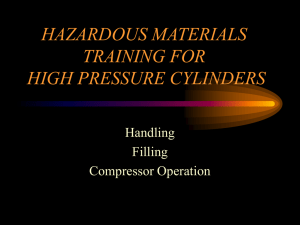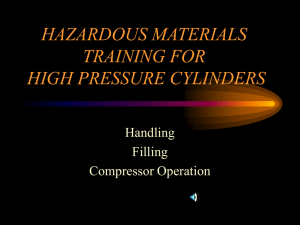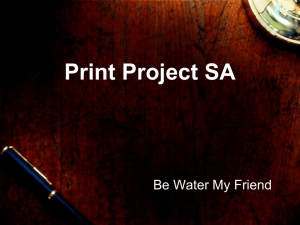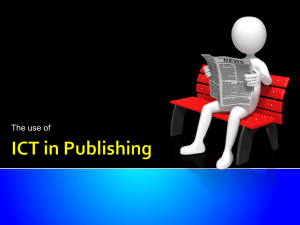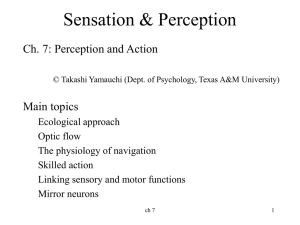HAZMAT TRAINING INSTRUCTOR GUIDE
advertisement
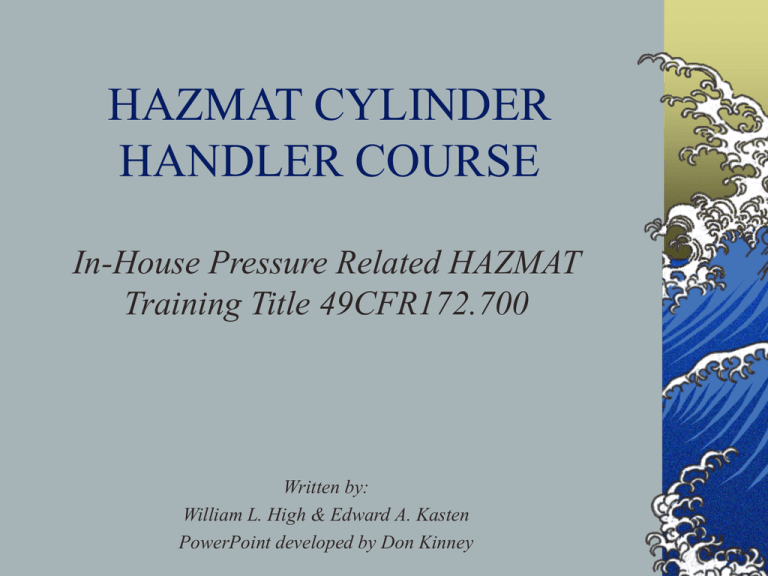
HAZMAT CYLINDER HANDLER COURSE In-House Pressure Related HAZMAT Training Title 49CFR172.700 Written by: William L. High & Edward A. Kasten PowerPoint developed by Don Kinney Code of Federal Regulations (CFR) Title 49-172.700 All Persons who handle, transport or are likely to be affected by the hazards of compressed gas cylinders and their contents shall receive appropriate safety training. Hazmat Training within the dive and fire protection industries should provide specific safety awareness for all applicable groups such as employees, service technicians, air fill station operators (FSO), Nitrox gas blenders as well as volunteer helpers, and even customers Regulatory Agencies Department of Transportation (DOT) regulates the transport and handling of high pressure cylinders Occupational Safety and Health Administration (OSHA)- regulates the safety of employees. These regulations only apply to employees. It would not apply to a sole proprietor with no employees. Required Employee Knowledge Know how to safely handle and fill cylinders Identify illegal or damaged cylinders Understand the hazards of high pressure air and, where Nitrox service is provided, mixing and gas transfer procedures. Training in Hazmat makes the workplace safer. Training Requirements Documented training should be provided to all employees before they encounter the real and potential hazards of compressed gas Within 90 days of hire Refresher training every 3 years By a certified instructor. PSI trained in inspections. A SCUBA instructor would not qualify. Training shall include: Hazmat training should be provided whenever an employee is assigned new duties. General awareness/familiarization training Function-specific training Safety Training to include: Emergency Response Employee Protection Accident Avoidment Safe handling Procedures Required Documentation A written record of the training for each Hazmat employee shall be maintained. A copy of the training material shall be maintained Documentation that the hazmat employee has been trained and tested. Record Keeping Records are essential evidence in any civil or criminal action Retain training and inspection records for at least 5 years The record should include: Participant signature Date and location of training Description of material Name and number of PSI instructor Consequences of Improper handling, Filling and inspection Several SCUBA or storage cylinders explode each year causing death, injury and property damage. The Kinetic energy stored within a full 80 cubic foot cylinder exceeds one million foot pounds: Enough to disintegrate walls and destroy vehicles About 90 percent of cylinder explosions occur during the filling process. Handling Dangers When you carry the cylinder by the valve keep opening away from your hand. Air embolism may occur through the skin if Secure cylinders to prevent movement Maximum operating temperature 130 deg. F Personal injury or cylinder damage may occur from dropped cylinder Service Pressure Service pressure must be clearly displayed on all cylinders The service pressure is established by a calibrated gauge at a constant 70 deg. F A fill station operator will have no defense against civil or criminal charges if the cylinder later fails explosively due to over pressurization of the cylinder Filling Policies Fill at 300 – 600 psig per minute to service pressure DO NOT over - pressurize cylinders Provide protection for FSO’s Reject (set aside for professional inspection) un-galvanized, steel coated cylinders Require all persons to remain away from fill station Cursory Inspection What to look for: Inspect exterior for damage caused by corrosion or exposure to heat Perform hammer test on Steel Cylinders (listen for bell-like tone) Look for EOI Sticker and proper hydrostatic test date Verify specification codes are proper In the U.S. only fill-ICC, DOT, CTC/DOT and TC/DOT Cylinders Check cylinder residual air for odor Inspect cylinder having zero pressure Be Alert for improper valves I.e. metric in national gas straight threaded cylinder Reject on Cursory Inspection Set aside for professional inspection the following cylinders: Bevel bottom aluminum cylinders (SP6576) Any aluminum cylinder marked with SP6688 Any cylinder marked with SP890 COMPOSITE SCBA older than 15 years Hoop wrap SCBA E7235 4500 NOT retrofitted SP6498, E6498, SP7042 and E7042 NOT Over-stamped with 3AL All round bottom aluminum cylinders Valves w/o pressure relief devices or with fusible plugs or known or suspected double discs Cylinders with known or suspected history of overfilling Cylinders with dents, bulges, line corrosion or pits Un-galvanized, vinyl-coated steel cylinders Disguised Damage Boots often hide corrosion damage Stickers may be placed over damage Auto Repair putty used to cover defects Owner attempt to apply interior coating of paint, zinc or epoxy Physically altered cylinder – cut and threaded to transport contraband Filling Cylinders Conduct a cursory inspection of all cylinders before filling. Most explosions could have been avoided by a simple cursory inspection The fill station operator may question the validity of the sticker Incomplete inspection Invalid inspection No sticker at all During fill, be cautious of a cylinder falling Condemned Cylinder Any cylinder marked condemned or having obliterated codes may NEVER be returned to service DO NOT FILL IT! A trained PSI cylinder inspector may condemn a cylinder Fire vs. Cylinders The Maximum sustained exposure temp. for 3AL cylinders is 265 degrees F Between 265 and 350 degrees the cylinder must be hydro-ed before being placed in service Reject the cylinder if exposed to over 350 deg. F and refer to a trained PSI inspector If any plastic has melted the cylinder has been exposed to temperatures in excess of 350 degrees. The tank must be condemned Visual Inspection If you have not been trained in Cylinders inspections – DO NOT DO IT! Title 20CFR1910.101(a) – Each Employer shall determine that compressed gas cylinders under his control are in a safe condition to the extent that this can be determined by visual inspection. Visual and other inspections shall be conducted as prescribed in the HAZMAT Regulations of DOT(49CFR, Parts 171-179 and 14CFR part 103). Where those regulations are not applicable, visual and other inspections shall be conducted in accordance with CGA pamphlet C-6. Visual Cursory Inspection Vs. Internal Inspection Anytime you fill/use a cylinder you should perform a cursory visual inspection. An internal inspection should be conducted at least annually by a trained PSI Inspector. If necessary - depending on circumstances – the cylinder may be inspected more often. Transporting Cylinders Secure the cylinders vertically If they can not be transported vertically, secure them horizontally facing sideways Valves placed forward or to the rear may shear in a crash causing catastrophic damage Transporting Cylinders According to DOT: When transporting cylinders for commerce, it is necessary to place placards on all four corners of your vehicle when the load of cylinders meets or exceeds 1000 pounds. Approximately 29 cylinders (aluminum) The placard must state: NON-FLAMMABLE GAS - AIR Cylinder Storage Store vertically, when possible, and secured tightly Store below 130 deg. F in a dry environment Protect from casual passersby O2 cylinders must be stored at least 20’ from flammable gas containers or combustible materials. Cascade or Bank System DOT storage cylinders are large (9” diameter by 51” long) Store in cool dry area Valve caps should remain on inactive tanks Secure cylinders with chain to prevent falling You should not roll a cylinder to move it. Use a proper dolly or other device. 10 year star service does not apply to cascade or banked cylinders when they are attached to a compressor. ASME Cylinders American Society of Mechanical Engineers (ASME) These cylinders are intended for permanent installations and do not require hydro retest. ASME cylinders should still be visually inspected at least annually ASME cylinders are usually plugged at each rounded end Sidewall plug allows the cylinder to be mounted horizontally and frequently drained. SCBA (Self-Contained Breathing Apparatus) OSHA 1910.134 Written standard operating procedures User must be instructed/trained in proper use of respirators Respirator must be cleaned and disinfected after each use Respirators for emergency use shall be thoroughly inspected at least once a month or after each use. SCBA Composite SCBA’s are generally manufactured starting with a thin aluminum shell. The shell is then reinforced with fiberglass or a carbon material. Manufacturing the cylinder this way makes it lighter for the user, but does NOT make it less susceptible to damage. SCBAs are NOT designed for SCUBA use SCBA cylinder SP12479 has been tested for scuba use but there are concerns about its continued use in underwater environment SCBA Information Cylinder Types (2000 psig-4500psig): Steel Aluminum Composite – hoop or full wrap Steel and Aluminum solid wall have an unlimited service life 5 year hydro retest interval ALL Composite cylinders are limited to a 15 year service life Fiberglass and Kevlar - 3 year hydro retest interval Carbon - 5 year hydro retest interval SCBA Operating Procedures SCBA’s manufactured by MSA ( Mine Safety Appliance) and Interspiro have been designed for emergency fill rates as high as 6,000 PSIG/MIN SCBA Limitations Although protected to some degree by the protective overwrap, the SCBA aluminum liner should not reach a sustained temperature exceeding 250 deg. F. SCBA Use Warn users against storage restraints that may cause cylinder abrasions. Composite cylinders are not designed for underwater use and should NOT be filled in a water bath. Examine exterior at least every 30 days. Look for: distortion, dents, cuts & abrasions SCBA’s require visual inspections Damage limits for composites are listed in the CGA manual C-6.2. SCBA Damage Levels Three Levels of Damage recognition Level 1 - Acceptable Normal wear and tear and Minor damage Level 2 - Rejected or Repaired Depth of damage is greater than .005” but less than the value appearing in CGA C6.2 Tank should be re-hydro tested after repair Level 3 - Condemn Damage or abrasions greater than CGA C6.2 value Frayed or delaminated fibers from the cylinder may be reason for condemning it. (Refer cylinder to trained PSI inspector for inspection) Resource Materials Inspecting Cylinders – By William (Bill) High Guide to SCUBA Cylinder Inspections – By Luxferesd5 Cylinder Manufacturing Luxfer SCBA Guide

